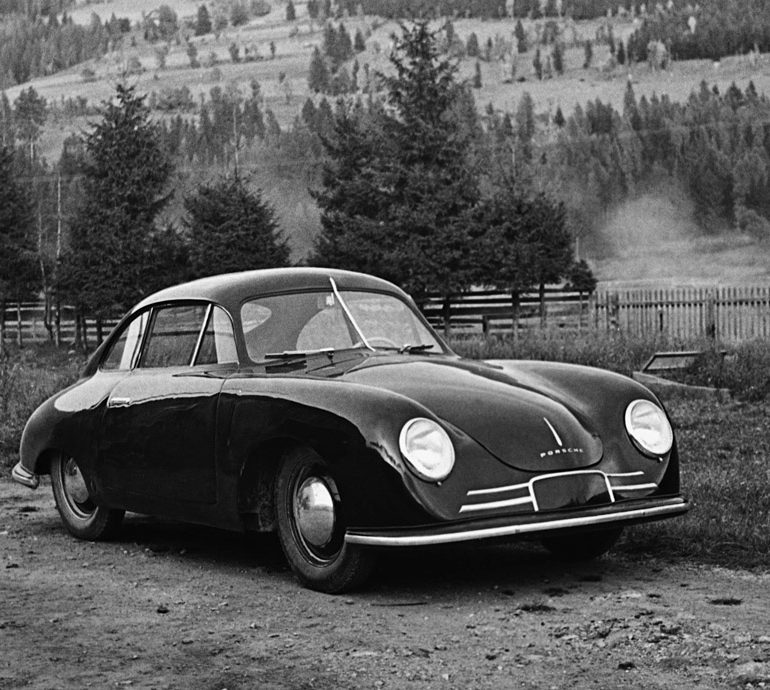1948→1951 Porsche 356/2 Gmünd Coupé
With lessons learned from 356 No. 1, Porsche developed the 356/2 as a production-ready version. The biggest concession to useability was repositioning the engine back behind the rear wheels as the original VW design. Like 356 No. 1, 356/2 was built as two-seat roadster using VW parts.
The steering, brakes, suspension, transmission, clutch and headlights were all sourced from Volkswagen. The 25 bhp engine was bored, fitted with larger valves and fitted with a higher-compression cylinder head to produce 35-40 bhp. Later into production Porsche sourced hydraulic brakes from Lockheed for the front brakes.
Unlike the tubular steel frame of the prototype, 356/2 was designed as a unitary steel tub which featured deep load-bearing sills, suspension pickup-points and mounts for the engine.
Due to the repositioned engine, the 356/2 was shorter than the prototype. The Erwin Komenda body was similar to the prototype, but had much longer rear overhang. Both a Coupé and Cabriolet were initially drawn up and went into production. Details such split windows, integrated bumpers, curved quarter windows and two small accent strips between the front indicators were typical of the Gmünd cars.
The first cars were funded by Swiss businessman and Rupprecht von Senger who paid for the first 50 cars and he bought the first Roadster to be launched at the the Swiss Grand Prix of 1948. With production shifting toward Stuttgart, the cabriolet bodies were all outsourced: six chassis were sent to Beutler by Bernard Blank for cabriolet bodywork. Later bodies were produced by Karosseriefabrik Ferdinand Keibl and Tatra in Vienna who produced only two additional cabriolets and several of the last coupes.1,2
In 1949 Porsche completed a new cylinder head for the 356 based off the Strumboot design for the light attack boats. These allowed for 38mm valves over the 38mm VW counterparts and increased power to 40 bhp. With a slight increase in bore, this setup offered the same power, only 200 rpm sooner.1
Porsche oversaw chassis development of the 356 while their fabricators worked hard at making coupe bodies. When the aluminum bodies were found to be too time consuming the production was outsourced.
Deliveries of the 356 began in 1949. That year two cars were shown at the Geneva Auto Show in March. The Motor responded by calling it “One of the smartest little cars of the show” and described it as having “the lowest floor and seating position we have seen in any non racing machine.” With its relatively high cost compared to a VW, the Porsche was selling based on the merits of Ferdinand and the higher costs for British and Italian sports cars.1
Most of the first cars were sold in Austria and Switzerland. 15 cars later went to Sweden as part of a deal with Scania-Vabis which took their final car in 1951. Total production of Gmünd cars was 49 cars, eight being cabriolets. Production resumed in Stuttgart with steel-bodied cars in 1950.1
Sources & Further Reading.
Sources & Further Reading.
1. Ludvigsen, Karl.Porsche. Excellence Was Expected. Bentley Publishers: 2003.
2. Carney, Philip & Jacques Mertens. The Last Eleven. 2011.
In Detail
| submitted by | Richard Owen |
| type | Series Production Car |
| production years | 1948 – 1951 |
| built at | Austria |
| production | 41 |
| price $ | $ 3,750 |
| engine | Type 369 Flat-4 |
| position | Rear, Longitudinal |
| valvetrain | Pushrod OHV |
| fuel feed | Dual Solex 26 VFJ Downdraft |
| displacement | 1086 cc / 66.27 in³ |
| compression | 6.5:1 |
| power | 29.8 kw / 40 bhp @ 4200 rpm |
| specific output | 36.83 bhp per litre |
| bhp/weight | 65.25 bhp per tonne |
| torque | 70.5 nm / 52 ft lbs @ 3300 rpm |
| body / frame | Aluminum Body over Tubular Steel Chassis |
| driven wheels | RWD |
| front tires | 5.00×6 |
| rear tires | 5.00×6 |
| steering | VW Worm & Nut |
| f suspension | VW Parallel Trailing Arms, Tubular Dampers |
| r suspension | VW Leading Arms w/Torsion Bars, Hydraulic Lever-Arm Shock Absorbers |
| curb weight | 613 kg / 1350 lbs |
| top speed | ~141.59 kph / 88 mph |
| fuel econ epa | 7.35 L/100 km or 32 mpg-us |
| fuel capacity | 50 litres or 13.20 gal. |






